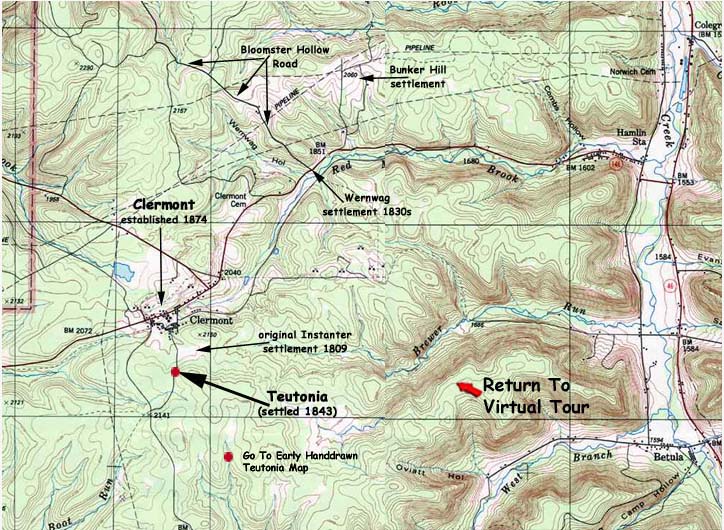The following is an article taken from the Bradford Era:
Teutonia: When Clermont resident Dave Johnson, a graduate
student on the West Coast, first wrote seeking background on Teutonia
about which he is writing a thesis, the item produced immediate response-
as we have told you.
We expect to hear more from Oscar Benton’s sources and from George
Rupprecht of Wilcox RD, who is writing a book on the region. But, today,
we’ll quote from the information sent along by Ernest Wagner of
76 W. Washington St., based on “Historical Collections of the State
of Pennsylvania.”
Here are some of the elements. Teutonia is the name of a
German town situated on the right bank of Stanton Creek, five miles southwest
of Smethport. The town, the source says, was the property of “The
Society of Industry.” It was begun in March of 1843 “on the
plan and enterprise of Mr. Henry Ginal,
a German now residing in Philadelphia, and an agent of the society.”
Teutonia, at the time the report was written, had about
450 inhabitants; at that period, there was a schoolhouse but no church.
Some 70 or 80 log houses had been erected, besides a steam sawmill, a
large tannery and a store furnished “with every article necessary
for food and clothing.”
The book said the society had 40,000 acres, “a considerable
part of which is already cleared, and they keep from forty to fifty hands
at chopping, all of them members of the society.”
The report adds that the lands had excellent bituminous coal, iron ore,
limestone, brick-clay and other things, with the soil generally of good
quality.
“The society is founded,” the account states, “on the
principle of community of property, money and furniture excepted, and
is sustained by the cooperation of its members; an equal distribution
of the profits being made half-yearly.
“In its fundamental principles it differs from Fourier’s system.
The society has about $40,000 capital; some $16,000 of which is invested
in land. This stock is divided into 660 shares, of which 360 are already
sold. When the balance is sold the number will be limited, and shareholders
will be admitted only by buying out others. The shares are now worth about
$200; originally they were only worth $100, but have risen with the improvements.”
As to the land itself, the book reports it was divided into several districts,
with a town in the center of each. Houses were built in uniform style
and plans called for stables and barns to be outside the village.
Marriage, we are told “is not only allowed but encouraged, and each
family resides in its separate house, possessing its own furniture and
money. Clothing of a plain and uniform kind, provisions, fuel etc. are
regularly distributed by rations from the society’s common stores.
“An individual becomes a member by purchasing a share of stock,
going on the ground, and working with the rest. The society will build
him a house if married; or furnish him or her with a lodging, if single.
Children, when they grow up, become members by conforming to the rules
of the society. Married women are not obliged to work for the community,
but devote their attention to the care of their own families. All religions
are tolerated here; (but it would perhaps be better if the society had
commenced with selecting some one in particular.)”
The wording of this report sounds almost like a prospectus. We’ll
return to it in the future. In the meantime, we hope Oscar Benton’s
friends or George Rupprecht can tell us what eventually happened to the
community.
|
